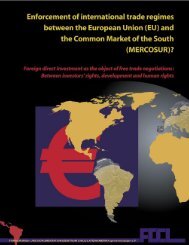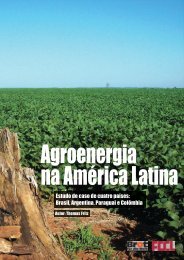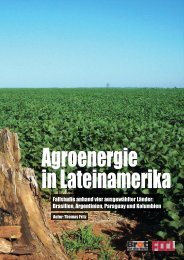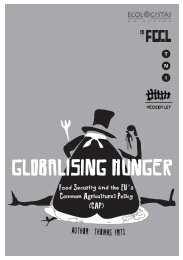(EU) and the Common Market of the South (MERCOSUR)? - FDCL
(EU) and the Common Market of the South (MERCOSUR)? - FDCL
(EU) and the Common Market of the South (MERCOSUR)? - FDCL
You also want an ePaper? Increase the reach of your titles
YUMPU automatically turns print PDFs into web optimized ePapers that Google loves.
82<br />
4. 1 The free trade agreement between <strong>EU</strong> <strong>and</strong> <strong>MERCOSUR</strong>: Interests <strong>of</strong><br />
companies, lobby groups <strong>and</strong> governments – The case <strong>of</strong> Brazil<br />
European corporations, which have been operating in <strong>MERCOSUR</strong> for years<br />
<strong>and</strong> which mainly concentrate on <strong>the</strong> domestic markets within <strong>MERCOSUR</strong>, in one<br />
respect have a smaller interest in rules for tariff reduction within <strong>the</strong> framework <strong>of</strong> a<br />
future FTA, as compared to, e.g., companies which produce in Europe <strong>and</strong> hope for<br />
sales advantages in foreign trade. European automobile producers in <strong>MERCOSUR</strong>,<br />
such as Volkswagen do Brazil, traditionally produce primarily for <strong>the</strong> domestic market.<br />
None<strong>the</strong>less, Volkswagen do Brazil is at <strong>the</strong> moment apparently trying to diversify<br />
its strategy <strong>of</strong> focussing on domestic markets through exports <strong>of</strong> automobiles<br />
produced in Brazil to <strong>the</strong> United States, Asia, Europe <strong>and</strong> Africa. 227 This new policy<br />
would also benefit from a tariff reduction in <strong>the</strong>se markets through a FTA: <strong>the</strong> European<br />
import tariffs for automobiles produced abroad are at 10 percent, in accordance<br />
with <strong>the</strong> WTO, for cars produced in Brazil according to <strong>the</strong> GSP tariffs (Generalized<br />
System <strong>of</strong> Preferences 228 ) <strong>the</strong>y are currently at 6.5 percent. 229 In <strong>MERCOSUR</strong>, however,<br />
import tariffs on automobiles produced outside <strong>of</strong> <strong>MERCOSUR</strong> are currently at<br />
35 percent. Such a constellation comes in h<strong>and</strong>y for corporations already located in<br />
<strong>MERCOSUR</strong>, but for corporations that are not yet present in <strong>the</strong> <strong>Common</strong> <strong>Market</strong> <strong>of</strong><br />
<strong>the</strong> <strong>South</strong>, this at <strong>the</strong> same time means a “disadvantage <strong>of</strong> non-location.”<br />
Mercedes Benz do Brazil in 1997 still produced forty thous<strong>and</strong> trucks <strong>and</strong> buses.<br />
In 2002 this number had fallen to 5,451 units. In 2003 production numbers again<br />
rose to 38,000, <strong>of</strong> which 9,300 were exported, which was in particular due to <strong>the</strong><br />
increasing dem<strong>and</strong> in Argentina. For 2004 a production <strong>of</strong> around 40,000 trucks <strong>and</strong><br />
buses is expected, where 30,000 will be produced for <strong>the</strong> Brazilian domestic market<br />
– which means that Brazil will advance to be <strong>the</strong> second largest market for Mercedes<br />
trucks <strong>and</strong> buses, led by <strong>the</strong> U.S. with 90,000 units <strong>and</strong> followed by Germany with<br />
27,300. On <strong>the</strong> o<strong>the</strong>r h<strong>and</strong>, <strong>the</strong> production <strong>of</strong> automobiles in <strong>the</strong> principle Mercedes<br />
plant in Brazil, Juiz de Fora, has been losing money for years, which according to<br />
management is due to <strong>the</strong> devalution <strong>of</strong> <strong>the</strong> Brazilian Real: again Mercedes here is<br />
227 http://www.estado.estadao.com.br/editorias/2003/06/28/eco022.html.<br />
228 “GSP: The Generalised system <strong>of</strong> preferences is a system by means <strong>of</strong> which preferential tariffs are granted<br />
unilaterally to certain countries on a non-reciprocal basis. It was approved by GATT in 1971, allowing industrialised<br />
members to adopt one-way tariff preferences in favour <strong>of</strong> developing countries. The waiver was made more general<br />
<strong>and</strong> permanent in 1979 with adoption <strong>of</strong> so-called “Enabling Clause” allowing industrialised countries to implement<br />
measures extending “differential <strong>and</strong> more favourable treatment” to developing countries. The <strong>EU</strong> launched this<br />
preferential system in 1971, in order to help developing countries sell more <strong>of</strong> <strong>the</strong>ir products in <strong>the</strong> industrialized<br />
countries <strong>and</strong> build up <strong>the</strong>ir own industry. The preferences under <strong>the</strong> GSP are granted to exports <strong>of</strong> specific<br />
products from particular countries.” http://europa.eu.int/comm/trade/gentools/glossarycont_en.htm#gsp.<br />
229 O Estado de São Paulo, December 2, 2003.









